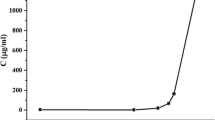Abstract
The objective of this study was to explore the feasibility of using alginate as a potential stabilizer of nanosuspension and elaborate the corresponding stabilization mechanism. Using lovastatin as a Biopharmaceutics Classification System (BCS) II drug model, alginate-stabilized nanosuspension was fabricated by the high-pressure homogenization method. The particle size, zeta potential, short-term stability, and dissolution behavior of the nanosuspension were characterized. Thereafter, the surface morphology, crystallinity, redispersability, and stability of the spray-dried nanosuspension were investigated. The spray-dried powder was further compressed into tablets via direct compression, and stressing test was carried out to investigate the stability of nanocrystal loaded tablets. It was demonstrated that alginate could stabilize nanocrystals by providing both electrostatic and steric stabilization, and the effective concentration was much lower than that of the commonly used stabilizers. Good redispersability was achieved after spray drying of the nanosuspension, and the existing state of lovastatin was not changed as indicated by X-ray powder diffraction (XRPD) and differential scanning calorimetry (DSC) studies. The stress test indicated that nanocrystal-loaded tablets possessed a favorable stability. In conclusion, alginate could be used as a potential stabilizer of nanosuspension with preferable stabilizing ability at a very low concentration either in liquid or in solid state.







Similar content being viewed by others
References
Merisko E. Liversidgenanocrystals: resolving pharmaceutical formulation issues associated with poorly soluble compounds. In: Matty JJ, editor. Particles. Orlando: Marcel Dekker; 2002.
Kohli K, Chopra S, Dhar D, Arora S, Khar RK. Self-emulsifying drug delivery systems: an approach to enhance oral bioavailability. Drug Discov Today. 2010;15(21–22):958–65.
Lipinski CA. Drug-like properties and the causes of poor solubility and poor permeability. J Pharmacol Toxicol. 2000;44(1):235–49.
Van Eerdenbrugh B, Stuyven B, Froyen L, Van Humbeeck J, Martens JA, Augustijns P, et al. Downscaling drug nanosuspension production: processing aspects and physicochemical characterization. AAPS PharmSciTech. 2009;10(1):44–53.
Chen H, Khemtong C, Yang X, Chang X, Gao J. Nanonization strategies for poorly water-soluble drugs. Drug Discov Today. 2011;16(7–8):354–60.
Mauludin R, Mueller RH, Keck CM. Development of an oral rutin nanocrystal formulation. Int J Pharm. 2009;370(1–2):202–9.
Gursoy RN, Benita S. Self-emulsifying drug delivery systems (SEDDS) for improved oral delivery of lipophilic drugs. Biomed Pharmacother. 2004;58(3):173–82.
Fricker G, Kromp T, Wendel A, Blume A, Zirkel J, Rebmann H, et al. Phospholipids and lipid-based formulations in oral drug delivery. Pharm Res. 2010;27(8):1469–86.
Rabinow BE. Nanosuspensions in drug delivery. Nat Rev Drug Discov. 2004;3(9):785–96.
Shegokar R, Mueller RH. Nanocrystals: industrially feasible multifunctional formulation technology for poorly soluble actives. Int J Pharm. 2010;399(1–2):129–39.
Muller RH, Jacobs C, Kayser O. Nanosuspensions as particulate drug formulations in therapy. Rationale for development and what we can expect for the future. Adv Drug Deliv Rev. 2001;47(1):3–19.
Junyaprasert VB, Morakul B. Nanocrystals for enhancement of oral bioavailability of poorly water-soluble drugs. Asian J Pharm Sci. 2015;10(1):13–23.
Obeidat WM, Sallam AA. Evaluation of tadalafil nanosuspensions and their PEG solid dispersion matrices for enhancing its dissolution properties. AAPS PharmSciTech. 2014;15(2):364–74.
Simonelli AP, Mehta SC, Higuchi WI. Inhibition of sulfathiazole crystal growth by polyvinylpyrrolidone. J Pharm Sci. 1970;59(5):633–8.
Itoh K, Tsuruya R, Shimoyama T, Watanabe H, Miyazaki S, D’Emanuele A, et al. In situ gelling xyloglucan/alginate liquid formulation for oral sustained drug delivery to dysphagic patients. Drug Dev Ind Pharm. 2010;36(4):449–55.
Zhang X, Guan J, Ni R, Li LC, Mao SR. Preparation and solidification of redispersible nanosuspensions. J Pharm Sci. 2014;103(7):2166–76.
Li L, Wang LL, Shao Y, Ni R, Zhang TT, Mao SR. Drug release characteristics from chitosan-alginate matrix tablets based on the theory of self-assembled film. Int J Pharm. 2013;450(1–2):197–207.
Van Eerdenbrugh B, Van den Mooter G, Augustijns P. Top-down production of drug nanocrystals: nanosuspension stabilization, miniaturization and transformation into solid products. Int J Pharm. 2008;364(1):64–75.
Sun W, Tian W, Zhang Y, He J, Mao S, Fang L. Effect of novel stabilizers—cationic polymers on the particle size and physical stability of poorly soluble drug nanocrystals. Nanomedicine: NBM. 2012;8(4):460–7.
Sun W, Mao S, Shi Y, Li LC, Fang L. Nanonization of itraconazole by high pressure homogenization: stabilizer optimization and effect of particle size on oral absorption. J Pharm Sci. 2011;100(8):3365–73.
Verma S, Gokhale R, Burgess DJ. A comparative study of top-down and bottom-up approaches for the preparation of micro/nanosuspensions. Int J Pharm. 2009;380(1–2):216–22.
Keck CM, Muller RH. Drug nanocrystals of poorly soluble drugs produced by high pressure homogenisation. Eur J Pharm Biopharm. 2006;62(1):3–16.
Mishra B, Sahoo J, Dixit PK. Formulation and process optimization of naproxen nanosuspensions stabilized by hydroxy propyl methyl cellulose. Carbohydr Polym. 2015;127:300–8.
Wang Y, Zheng Y, Zhang L, Wang Q, Zhang D. Stability of nanosuspensions in drug delivery. J Control Release. 2013;172(3):1126–41.
Smidsrød O. Solution properties of alginate. Carbohydr Res. 1970;13(3):359–72.
Choi J-Y, Park CH, Lee J. Effect of polymer molecular weight on nanocomminution of poorly soluble drug. Drug Deliv. 2008;15(5):347–53.
Lipatov YS, Dudarenko G, Chornaya V, Todosiichuk T. Change of molecular weight distribution of polymers by adsorption from binary and ternary solutions. Colloids Surf A Physicochem Eng Asp. 2008;326(1):53–60.
Yamasaki K, Kwok PC, Fukushige K, Prud’homme RK, Chan HK. Enhanced dissolution of inhalable cyclosporine nano-matrix particles with mannitol as matrix former. Int J Pharm. 2011;420:34–42.
Acknowledgements
This work was financially support by FMC Corporation, USA.
Author information
Authors and Affiliations
Corresponding author
Ethics declarations
Conflict of interest
The authors declare that they have no conflict of interest.
Rights and permissions
About this article
Cite this article
Guan, J., Zhang, Y., Liu, Q. et al. Exploration of alginates as potential stabilizers of nanosuspension. AAPS PharmSciTech 18, 3172–3181 (2017). https://doi.org/10.1208/s12249-017-0801-6
Received:
Accepted:
Published:
Issue Date:
DOI: https://doi.org/10.1208/s12249-017-0801-6




